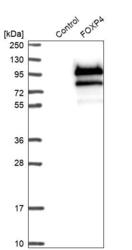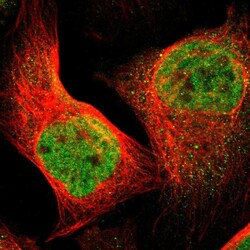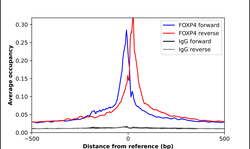Antibody data
- Antibody Data
- Antigen structure
- References [5]
- Comments [0]
- Validations
- Western blot [1]
- Immunocytochemistry [1]
- Chromatin Immunoprecipitation [1]
Submit
Validation data
Reference
Comment
Report error
- Product number
- HPA007176 - Provider product page

- Provider
- Atlas Antibodies
- Proper citation
- Atlas Antibodies Cat#HPA007176, RRID:AB_1078911
- Product name
- Anti-FOXP4
- Antibody type
- Polyclonal
- Description
- Polyclonal Antibody against Human FOXP4, Gene description: forkhead box P4, Alternative Gene Names: FLJ40908, Validated applications: ICC, WB, ChIP, IHC, Uniprot ID: Q8IVH2, Storage: Store at +4°C for short term storage. Long time storage is recommended at -20°C.
- Reactivity
- Human
- Host
- Rabbit
- Conjugate
- Unconjugated
- Isotype
- IgG
- Vial size
- 100 µl
- Concentration
- 0.3 mg/ml
- Storage
- Store at +4°C for short term storage. Long time storage is recommended at -20°C.
- Handling
- The antibody solution should be gently mixed before use.
Submitted references Androgen-responsive FOXP4 is a target for endometrial carcinoma
Androgen promotes squamous differentiation of atypical cells in cervical intraepithelial neoplasia via an ELF3‐dependent pathway
Spatiotemporal single-cell regulatory atlas reveals neural crest lineage diversification and cellular function during tooth morphogenesis
FOXP4 inhibits squamous differentiation of atypical cells in cervical intraepithelial neoplasia via an ELF3‐dependent pathway
Kayahashi K, Hasan M, Khatun A, Kohno S, Terakawa J, Horike S, Toyoda N, Matsuoka A, Iizuka T, Obata T, Ono M, Mizumoto Y, Takahashi C, Fujiwara H, Daikoku T
Communications Biology 2024;7(1)
Communications Biology 2024;7(1)
Chung E, Deacon P, Hu Y, Lim H, Park J
2024
2024
Androgen promotes squamous differentiation of atypical cells in cervical intraepithelial neoplasia via an ELF3‐dependent pathway
Matsumoto T, Suzuki T, Nakamura M, Yamamoto M, Iizuka T, Ono M, Kagami K, Kasama H, Kanda T, Sakai Y, Iwadare J, Matsuoka A, Kayahashi K, Wakae K, Muramatsu M, Kyo S, Yamamoto Y, Mizumoto Y, Daikoku T, Fujiwara H
Cancer Medicine 2023;12(9):10816-10828
Cancer Medicine 2023;12(9):10816-10828
Spatiotemporal single-cell regulatory atlas reveals neural crest lineage diversification and cellular function during tooth morphogenesis
Jing J, Feng J, Yuan Y, Guo T, Lei J, Pei F, Ho T, Chai Y
Nature Communications 2022;13(1)
Nature Communications 2022;13(1)
FOXP4 inhibits squamous differentiation of atypical cells in cervical intraepithelial neoplasia via an ELF3‐dependent pathway
Matsumoto T, Iizuka T, Nakamura M, Suzuki T, Yamamoto M, Ono M, Kagami K, Kasama H, Wakae K, Muramatsu M, Horike S, Kyo S, Yamamoto Y, Mizumoto Y, Daikoku T, Fujiwara H
Cancer Science 2022;113(10):3376-3389
Cancer Science 2022;113(10):3376-3389
No comments: Submit comment
Enhanced validation
- Submitted by
- Atlas Antibodies (provider)
- Enhanced method
- Recombinant expression validation
- Main image

- Experimental details
- Western blot analysis in control (vector only transfected HEK293T lysate) and FOXP4 over-expression lysate (Co-expressed with a C-terminal myc-DDK tag (~3.1 kDa) in mammalian HEK293T cells, LY408607).
- Sample type
- Human
- Protocol
- Protocol
Supportive validation
- Submitted by
- Atlas Antibodies (provider)
- Main image

- Experimental details
- Immunofluorescent staining of human cell line U-2 OS shows localization to nucleoplasm.
- Sample type
- Human
Supportive validation
- Submitted by
- Atlas Antibodies (provider)
- Main image

- Experimental details
- ChIP-Exo-Seq composite graph for Anti-FOXP4 (HPA007176, Lot 00009344) tested in K562 cells. Strand-specific reads (blue: forward, red: reverse) and IgG controls (black: forward, grey: reverse) are plotted against the distance from a composite set of reference binding sites. The antibody exhibits robust target enrichment compared to a non-specific IgG control and precisely reveals its structural organization around the binding site. Data generated by Prof. B. F. Pugh´s Lab at Cornell University.
 Explore
Explore Validate
Validate Learn
Learn Western blot
Western blot Immunocytochemistry
Immunocytochemistry Immunohistochemistry
Immunohistochemistry